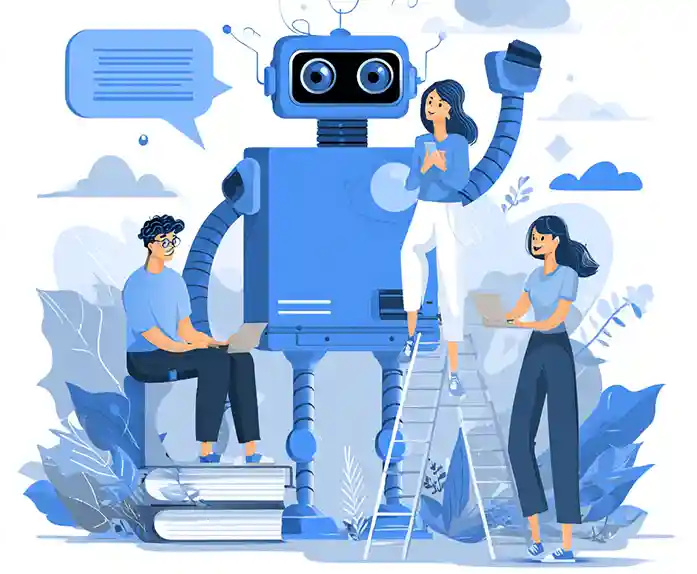What is a Custom GPT?

Sara Williams

Since the release of GPT-4, generative AI has rapidly become a foundational part of how businesses interact with customers, manage content, and automate internal workflows. But for many teams, a generic chatbot (even one as powerful as ChatGPT) isn’t enough.
That’s where Custom GPTs come in.
OpenAI’s Custom GPT capability enables individuals and organizations to create tailored versions of GPT-4 that reflect their specific needs, domain knowledge, tools, and tone of voice. Whether you're building an AI support agent, onboarding assistant, or sales copilot, Custom GPTs offer a no-code (or low-code) way to deliver a highly personalized experience.
In this post, we’ll explore what a Custom GPT is, how it works, how it compares to other AI customization methods, and how it fits into the broader ecosystem of AI agents like those built with CrafterQ.
Custom GPT in a Nutshell
A Custom GPT is a version of OpenAI’s ChatGPT that has been configured with specific instructions, tools, knowledge, and behaviors, allowing it to perform more specialized tasks. It’s built using OpenAI’s ChatGPT interface and can be deployed as a standalone assistant within the ChatGPT product (Pro users only), or as part of a broader AI-powered experience.
Importantly, a Custom GPT is not fine-tuned at the model level. Instead, it leverages:
-
Custom instructions and system prompts
-
Knowledge files (uploaded documents)
-
API tools and function calling
-
Predefined tone, behavior, and limitations
This allows teams to build domain-aware agents that feel less like a generic chatbot and more like a real expert that understands your business.
How Custom GPTs Work
Building a Custom GPT involves configuring a set of components in OpenAI’s GPT Builder UI. Here's a breakdown of how it works under the hood:
1. Custom Instructions
You define the behavior of your agent using natural language. These instructions are transformed into a system message that guides the model’s tone, goals, and constraints.
Examples:
-
“You are a friendly onboarding assistant for a SaaS company.”
-
“Always answer using the company’s product terminology and link to documentation when relevant.”
-
“Avoid discussing competitors.”
2. Knowledge Uploads
You can upload files (PDFs, Word docs, Markdown, etc.) to provide grounding knowledge. These documents are indexed and searched using embeddings (similar to a RAG pipeline), allowing the model to answer questions based on your content.
This is crucial for:
-
Product documentation
-
Company policies
-
Training manuals
-
Support FAQs
3. Tool Integration (Function Calling)
Custom GPTs can also be given access to external APIs and tools. You define the schema (parameters, descriptions, endpoints), and GPT will call those tools automatically when it decides the function is relevant to the task.
This allows you to extend the agent’s capabilities to:
-
Query databases
-
Fetch live data
-
Trigger workflows (e.g. create a support ticket)
-
Perform calculations or lookups
4. User Interface and Deployment
Once configured, your Custom GPT is accessible within the ChatGPT interface (for Pro users), with a custom name, profile image, and greeting. You can share it via a link or embed it in internal documentation, though OpenAI currently restricts direct third-party deployments without API use.
Custom GPT vs Fine-Tuning vs RAG
Let’s clarify how Custom GPTs compare to other methods of customizing AI:
| Approach | Description | Pros | Cons |
|---|---|---|---|
| Custom GPT | Instruction + file upload + tool config | Fast, no code, flexible, conversational | Limited to OpenAI’s hosted platform |
| Fine-Tuning | Retrains model weights on labeled examples | Precise control over model behavior | Requires data, compute, time; less flexible |
| RAG (Retrieval-Augmented Generation) | Dynamically injects external knowledge into prompt | Scalable, updatable, works with APIs | Requires custom engineering & infra |
At CrafterQ, we take the RAG and agent-based approach to the next level allowing you to build fully custom, branded, and embeddable AI agents that use your content and connect to your systems. Unlike Custom GPTs, CrafterQ agents are not tied to a specific provider and can be deployed anywhere.
Why Use a Custom GPT?
For many teams, Custom GPTs are an easy entry point into building AI-powered solutions tailored to their business. Common use cases include:
✅ AI Support Agents
Upload your support docs and create a helpful, always-on assistant that can answer questions and escalate when needed.
✅ Product Onboarding
Guide new users through your product with a friendly GPT trained on how-to guides and tutorials.
✅ Sales Enablement
Equip sales reps with a GPT that can surface product info, case studies, and competitive talking points instantly.
✅ Internal Knowledge Assistants
Build a GPT that helps employees navigate internal processes, HR policies, and IT troubleshooting.
Limitations of Basic Custom GPTs
While Custom GPTs are powerful, they do have some limitations, especially for enterprise-grade deployments:
-
Not embeddable in your own site or app
-
No fine-grained analytics or logging
-
Hard to version or test in CI/CD workflows
-
Limited control over token limits and latency
-
Requires ChatGPT Pro to use
For organizations needing full control over branding, data, compliance, and observability, agent platforms like CrafterQ offer more flexibility. CrafterQ agents can integrate with any website or portal, use any data source, and support enterprise policies.
How CrafterQ Lets You Build a Custom GPT With Enterprise Flexibility
While OpenAI’s Custom GPTs are a great starting point, they come with real limitations, especially when you need full control over branding, data privacy, and deployment. That’s where CrafterQ comes in.
CrafterQ lets you build your own “Custom GPT,” but with all the features you’d expect from an enterprise-grade AI agent platform. You get the simplicity of creating a conversational assistant trained on your content, plus the flexibility, extensibility, and compliance features required for real-world business use.
🔧 Key Advantages of CrafterQ Over Basic Custom GPTs:
-
Deploy Anywhere: Unlike OpenAI’s Custom GPTs, CrafterQ agents can be embedded in your website, mobile app, customer portal, or internal tools, whether public or private.
-
Train on Any Data Source: Ingest your website, documents, support content, and other sources. Keep data fresh, relevant, and securely under your control.
-
Branded Experiences: Fully customize the look, tone, and behavior of your AI agent to match your desired customer experience. No visible third-party branding or UX limitations.
- Built-In Analytics & Feedback Loops: CrafterQ provides real-time insights into agent performance, user engagement, query trends, and response accuracy, all of which enables continuous tuning and optimization based on real usage data.
-
Powerful Tools and APIs: CrafterQ agents are API-first, support custom system prompts, tools and function calling, leverage both short-term and long-term memory, and enable model fine-tuning through Q&A, all orchestrated through a clean, user-friendly interface.
-
Enterprise-Ready Architecture: Get fine-grained user logs, SOC2 security, access controls, and private/self-hosted deployment options to meet your organization’s security and compliance requirements.
-
Team and Multi-Tenant Support: Manage multiple agents for different products, brands, or clients from one centralized platform.
In short, CrafterQ gives you the freedom to build a truly custom GPT-like experience without being locked into someone else’s platform or ecosystem. You control the data, the experience, and the outcome.
Whether you're creating a customer-facing support agent, a smart knowledge-based product assistant, or a personalized sales companion, CrafterQ offers the infrastructure to scale your AI assistant from prototype to production.
Summary
Custom GPTs represent a major step forward in democratizing access to AI customization. With a simple UI and no-code setup, anyone can build a capable, intelligent assistant trained on their data and tailored to their brand.
But for teams that need to embed these agents into their own digital experiences, including websites, e-commerce sites, customer portals, SaaS products, intranets and more, a flexible and open solution is required.
That’s why we built CrafterQ: to give businesses the tools they need to build custom AI agents that are trained on your content, deployed on your digital channels, and focused on delivering real business results.



